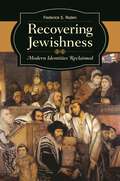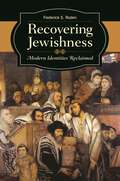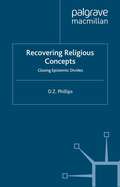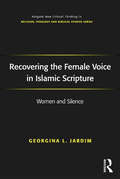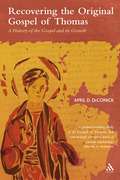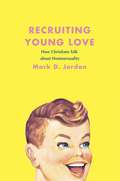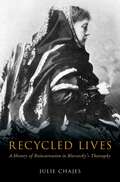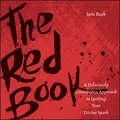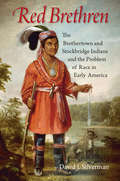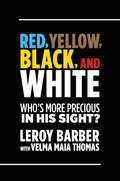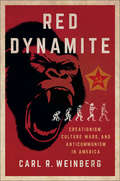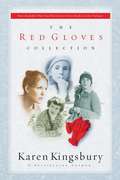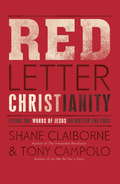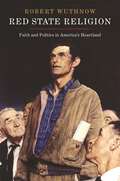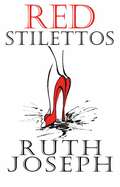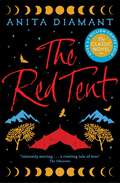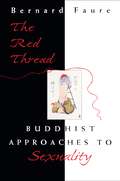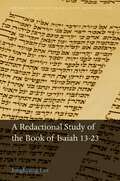- Table View
- List View
Recovering Jewishness: Modern Identities Reclaimed
by Frederick S. RodenJudaism and Jewish life reflect a diversity of identity after the past two centuries of modernization. This work examines how the early reformers of the 19th century and their legacy into the 20th century created a livable, liberal Jewish identity that allowed a reinvention of what it meant to be Jewish—a process that continues today.Many scholars of the modern Jewish identity focus on the ways in which the past two centuries have resulted in the loss of Jewishness: through "assimilation," intermarriage, conversion to other faiths, genocide (in the Holocaust), and decline in religious observance. In this work, author Frederick S. Roden presents a decidedly different perspective: that the changes in Judaism throughout the 19th and 20th centuries resulted in a malleable, welcoming, and expanded Jewish identity—one that has benefited from intermarriage and converts to Judaism. The book examines key issues in the modern definition of Jewish identity: who is and is not considered a Jew, and why; issues of Jewish "authenticity"; and the recent history of the debate. Attention is paid to the experiences of individuals who came to Judaism from outside the tradition: through marrying into Jewish families and/or choosing Judaism as a religion. In his consideration of the tragedy of the Holocaust, the author examines how a totalitarian regime's racial policing of Jewish identity served to awaken a connection with and reconfiguration of what that Jewish identity meant for those who retrospectively realized their Jewishness in the postwar era.
Recovering Jewishness: Modern Identities Reclaimed
by Frederick S. RodenJudaism and Jewish life reflect a diversity of identity after the past two centuries of modernization. This work examines how the early reformers of the 19th century and their legacy into the 20th century created a livable, liberal Jewish identity that allowed a reinvention of what it meant to be Jewish—a process that continues today.Many scholars of the modern Jewish identity focus on the ways in which the past two centuries have resulted in the loss of Jewishness: through "assimilation," intermarriage, conversion to other faiths, genocide (in the Holocaust), and decline in religious observance. In this work, author Frederick S. Roden presents a decidedly different perspective: that the changes in Judaism throughout the 19th and 20th centuries resulted in a malleable, welcoming, and expanded Jewish identity—one that has benefited from intermarriage and converts to Judaism. The book examines key issues in the modern definition of Jewish identity: who is and is not considered a Jew, and why; issues of Jewish "authenticity"; and the recent history of the debate. Attention is paid to the experiences of individuals who came to Judaism from outside the tradition: through marrying into Jewish families and/or choosing Judaism as a religion. In his consideration of the tragedy of the Holocaust, the author examines how a totalitarian regime's racial policing of Jewish identity served to awaken a connection with and reconfiguration of what that Jewish identity meant for those who retrospectively realized their Jewishness in the postwar era.
Recovering Religious Concepts: Closing Epistemic Divides (Swansea Studies in Philosophy)
by D. PhillipsHere it is argued that we need to recover concepts from the distortions of philosophy. In this collection the author shows the disastrous consequences for an understanding of religion of the epistemic divides which can be found in contemporary philosophy of religion; divides between belief and practice, the world and God, religious experience and religious contexts. By closing these divides religious significance is given its proper place.
Recovering the Female Voice in Islamic Scripture: Women and Silence (Routledge New Critical Thinking in Religion, Theology and Biblical Studies)
by Georgina L. JardimProtest is an activity not associated with the pious and collectively-minded, but more often seen as an activity of the liberal and rebellious. Judaism, Christianity and Islam are commonly understood as paragons of submission and obedience following Abraham’s example. Yet, the scriptures of all three faiths are founded in the prophets protesting wrongs in the social order. The Qur'an claims that men and women, and the relations between them are a sign from God. The question is to what extent are women silenced in the text, and do they share with men in shaping the prophetic scriptures? This book finds that far from silencing women, the Qur'an affirms the female voice as protester for justice and as questioner of Theology. In this reading of the female role in divine revelation in the Islamic text, Georgina Jardim returns to the scriptures of the Judeo-Christian counterpart of the Abrahamic faiths, to investigate whether the Bible may claim women as brokers of revelation. The result is an enriched understanding of divine communication in the Abrahamic scriptures and a commonplace for reasoning about the female voice as speaker in the Word of God.
Recovering the Female Voice in Islamic Scripture: Women and Silence (Routledge New Critical Thinking in Religion, Theology and Biblical Studies)
by Georgina L. JardimProtest is an activity not associated with the pious and collectively-minded, but more often seen as an activity of the liberal and rebellious. Judaism, Christianity and Islam are commonly understood as paragons of submission and obedience following Abraham’s example. Yet, the scriptures of all three faiths are founded in the prophets protesting wrongs in the social order. The Qur'an claims that men and women, and the relations between them are a sign from God. The question is to what extent are women silenced in the text, and do they share with men in shaping the prophetic scriptures? This book finds that far from silencing women, the Qur'an affirms the female voice as protester for justice and as questioner of Theology. In this reading of the female role in divine revelation in the Islamic text, Georgina Jardim returns to the scriptures of the Judeo-Christian counterpart of the Abrahamic faiths, to investigate whether the Bible may claim women as brokers of revelation. The result is an enriched understanding of divine communication in the Abrahamic scriptures and a commonplace for reasoning about the female voice as speaker in the Word of God.
Recovering the Original Gospel of Thomas: A History of the Gospel and its Growth (The Library of New Testament Studies #286)
by April D. DeConickThis book explores the fascinating and enigmatic collection of 114 sayings of Jesus, the 'Gospel of Thomas' that was discovered in the sands of Nag Hammadi, Egypt, in the 1940's. Since its discovery, scholars and the public alike have been intrigued to know what the Gospel says and what light it sheds on the formation of early Christianity. Here, DeConick provides a new English translation of the entire Gospel of Thomas, which includes the original 'kernel' of the Gospel and all the sayings. A unique feature of this book is that translations to the parallels of the Gospel are also included.
Recruiting Young Love: How Christians Talk about Homosexuality
by Mark D. JordanIn the view of many Christians, the teenage years are simultaneously the most dangerous and the most promising. At the very moment when teens are trying to establish a sense of identity and belonging, they are beset by temptation on all sides—from the pressure of their peers to the nihilism and materialism of popular culture. Add the specter of homosexuality to the mix, and you’ve got a situation ripe for worry, sermonizing, and exploitation. In Recruiting Young Love, Mark D. Jordan explores more than a half century of American church debate about homosexuality to show that even as the main lesson—homosexuality is bad, teens are vulnerable—has remained constant, the arguments and assumptions have changed remarkably. At the time of the first Kinsey Report, in 1948, homosexuality was simultaneously condemned and little discussed—a teen struggling with same-sex desire would have found little specific guidance. Sixty years later, church rhetoric has undergone a radical shift, as silence has given way to frequent, public, detailed discussion of homosexuality and its perceived dangers. Along the way, churches have quietly adopted much of the language and ideas of modern sexology, psychiatry, and social reformers—deploying it, for example, to buttress the credentials of anti-gay “deprogramming” centers and traditional gender roles. Jordan tells this story through a wide variety of sources, including oral histories, interviews, memoirs, and even pulp novels; the result is a fascinating window onto the never-ending battle for the teenage soul.
Recycled Lives: A History of Reincarnation in Blavatsky's Theosophy (Oxford Studies in Western Esotericism)
by Julie ChajesA sizeable minority of people with no particular connection to Eastern religions now believe in reincarnation. The rise in popularity of this belief over the last century and a half is directly traceable to the impact of the nineteenth century's largest and most influential Western esoteric movement, the Theosophical Society. In Recycled Lives, Julie Chajes looks at the rebirth doctrines of the matriarch of Theosophy, the controversial occultist Helena Petrovna Blavatsky (1831-1891). Examining her teachings in detail, Chajes places them in the context of multiple dimensions of nineteenth-century intellectual and cultural life. In particular, she explores Blavatsky's readings (and misreadings) of Spiritualist currents, scientific theories, Platonism, and Hindu and Buddhist thought. These in turn are set in relief against broader nineteenth-century American and European trends. The chapters come together to reveal the contours of a modern perspective on reincarnation that is inseparable from the nineteenth-century discourses within which it emerged, and which has shaped how people in the West tend to view reincarnation today.
Recycled Lives: A History of Reincarnation in Blavatsky's Theosophy (Oxford Studies in Western Esotericism)
by Julie ChajesA sizeable minority of people with no particular connection to Eastern religions now believe in reincarnation. The rise in popularity of this belief over the last century and a half is directly traceable to the impact of the nineteenth century's largest and most influential Western esoteric movement, the Theosophical Society. In Recycled Lives, Julie Chajes looks at the rebirth doctrines of the matriarch of Theosophy, the controversial occultist Helena Petrovna Blavatsky (1831-1891). Examining her teachings in detail, Chajes places them in the context of multiple dimensions of nineteenth-century intellectual and cultural life. In particular, she explores Blavatsky's readings (and misreadings) of Spiritualist currents, scientific theories, Platonism, and Hindu and Buddhist thought. These in turn are set in relief against broader nineteenth-century American and European trends. The chapters come together to reveal the contours of a modern perspective on reincarnation that is inseparable from the nineteenth-century discourses within which it emerged, and which has shaped how people in the West tend to view reincarnation today.
The Red Book: A Deliciously Unorthodox Approach to Igniting Your Divine Spark
by Sera J. BeakThe Red Book is nothing less than a spiritual fire starter -- a combustible cocktail of Hindu Tantra and Zen Buddhism, Rumi and Carl Jung, goddesses and psychics, shaken with cosmic nudges, meaningful subway rides, haircuts, relationships, sex, dreams, and intuition. Author Sera Beak's unique hybrid perspective, hilarious personal anecdotes, and invaluable exercises encourage her readers to live more consciously so they can start making clearer choices across the board, from careers to relationships, politics to pop culture and everything in between. For smart, gutsy, spiritually curious women whose colorful and complicated lives aren’t reflected in most spirituality books, The Red Book is an open invitation to find your true self and start sharing that delicious truth with the world.
Red Brethren: The Brothertown and Stockbridge Indians and the Problem of Race in Early America
by David J. SilvermanNew England Indians created the multitribal Brothertown and Stockbridge communities during the eighteenth century with the intent of using Christianity and civilized reforms to cope with white expansion. In Red Brethren, David J. Silverman considers the stories of these communities and argues that Indians in early America were racial thinkers in their own right and that indigenous people rallied together as Indians not only in the context of violent resistance but also in campaigns to adjust peacefully to white dominion. All too often, the Indians discovered that their many concessions to white demands earned them no relief. In the era of the American Revolution, the pressure of white settlements forced the Brothertowns and Stockbridges from New England to Oneida country in upstate New York. During the early nineteenth century, whites forced these Indians from Oneida country, too, until they finally wound up in Wisconsin. Tired of moving, in the 1830s and 1840s, the Brothertowns and Stockbridges became some of the first Indians to accept U.S. citizenship, which they called "becoming white," in the hope that this status would enable them to remain as Indians in Wisconsin. Even then, whites would not leave them alone.Red Brethren traces the evolution of Indian ideas about race under this relentless pressure. In the early seventeenth century, indigenous people did not conceive of themselves as Indian. They sharpened their sense of Indian identity as they realized that Christianity would not bridge their many differences with whites, and as they fought to keep blacks out of their communities. The stories of Brothertown and Stockbridge shed light on the dynamism of Indians' own racial history and the place of Indians in the racial history of early America.
Red, Brown, Yellow, Black, White-Who's More Precious In God's Sight?: A call for diversity in Christian missions and ministry
by Leroy BarberDrawing upon two decades of mission experience, Leroy Barber exposes the racial divisions within Christian ministries and offers practical and comprehensive solutions for promoting diversity. RED, BROWN, YELLOW, BLACK AND WHITE highlights the historic patterns that have created racial discrepancies within missions. It joins the essential canon created by touchstone books like Divided by Faith by Michael Emerson and Christian Smith and the ever-popular Race Matters by Cornel West. With a no-blame attitude, powerful personal narratives from a dozen other black, Hispanic, Asian, Native American and white Christians, interactive histories of missions, and the writings of MLK and Howard Thurman (the entire "Letter From Birmingham Jail" and Howard Thurman's motivational speech "Sound of the Genuine"), Barber addresses this tough issue in a way that will inspire and motivate readers of all races toward change.
RED, BROWN, YELLOW, BLACK, WHITE -- WHO'S MORE PRECIOUS IN GOD'S SIGHT?: A Call for Diversity in Christian Missions and Ministry
by Leroy BarberDrawing upon two decades of mission experience, Leroy Barber exposes the racial divisions within Christian ministries and offers practical and comprehensive solutions for promoting diversity. Red, Brown, Yellow, Black and White highlights the historic patterns that have created racial discrepancies within missions. It joins the essential canon created by touchstone books like Divided by Faith by Michael Emerson and Christian Smith and the ever-popular Race Matters by Cornel West. With a no-blame attitude, powerful personal narratives from a dozen other black, Hispanic, Asian, Native American and white Christians, interactive histories of missions, and the writings of MLK and Howard Thurman (the entire "Letter From Birmingham Jail" and Howard Thurman's motivational speech "Sound of the Genuine"), Barber addresses this tough issue in a way that will inspire and motivate readers of all races toward change.
Red Dynamite: Creationism, Culture Wars, and Anticommunism in America (Religion and American Public Life)
by Carl R. WeinbergIn Red Dynamite, Carl R. Weinberg argues that creationism's tenacious hold on American public life depended on culture-war politics inextricably embedded in religion. Many Christian conservatives were convinced that evolutionary thought promoted immoral and even bestial social, sexual, and political behavior. The "fruits" of subscribing to Darwinism were, in their minds, a dangerous rearrangement of God-given standards and the unsettling of traditional hierarchies of power. Despite claiming to focus exclusively on science and religion, creationists were practicing politics. Their anticommunist campaign, often infused with conspiracy theory, gained power from the fact that the Marxist founders, the early Bolshevik leaders, and their American allies were staunch evolutionists. Using the Scopes "Monkey" Trial as a starting point, Red Dynamite traces the politically explosive union of Darwinism and communism over the next century. Across those years, social evolution was the primary target of creationists, and their "ideas have consequences" strategy instilled fear that shaped the contours of America's culture wars. By taking the anticommunist arguments of creationists seriously, Weinberg reveals a neglected dimension of antievolutionism and illuminates a source of the creationist movement's continuing strength. Thanks to generous funding from Indiana University and its participation in TOME (Toward an Open Monograph Ecosystem), the ebook editions of this book are available as Open Access volumes from Cornell Open (cornellpress.cornell.edu/cornell-open) and other repositories.
The Red Gloves Collection
by Karen KingsburyCompiled in this collector edition are Gideon's Gift, Sarah's Song, Maggie's Miracle, and Hannah's Hope. Readers worldwide have been touched by these heart-warming tales of hope, inspiration, and joyous miracles by bestselling author Karen Kingsbury.
Red-Hot and Righteous: The Urban Religion of The Salvation Army
by Diane WinstonIn this engrossing study of religion, urban life, and commercial culture, Diane Winston shows how a (self-styled "red-hot") militant Protestant mission established a beachhead in the modern city. When The Salvation Army, a British evangelical movement, landed in New York in 1880, local citizens called its eye-catching advertisements "vulgar" and dubbed its brass bands, female preachers, and overheated services "sensationalist." Yet a little more than a century later, this ragtag missionary movement had evolved into the nation's largest charitable fund-raiser--the very exemplar of America's most cherished values of social service and religious commitment. Winston illustrates how the Army borrowed the forms and idioms of popular entertainments, commercial emporiums, and master marketers to deliver its message. In contrast to histories that relegate religion to the sidelines of urban society, her book shows that Salvationists were at the center of debates about social services for the urban poor, the changing position of women, and the evolution of a consumer culture. She also describes Salvationist influence on contemporary life--from the public's post-World War I (and ongoing) love affair with the doughnut to the Salvationist young woman's career as a Hollywood icon to the institutionalization of religious ideals into nonsectarian social programs. Winston's vivid account of a street savvy religious mission transformed over the decades makes adroit use of performance theory and material culture studies to create an evocative portrait of a beloved yet little understood religious movement. Her book provides striking evidence that, counter to conventional wisdom, religion was among the seminal social forces that shaped modern, urban America--and, in the process, found new expression for its own ideals.
Red Letter Christianity: Living the Words of Jesus No Matter the Cost
by Shane Claiborne Tony CampoloIn RED LETTER CHRISTIANITY Shane Claiborne and Tony Campolo explore what it means to take seriously the words of Jesus. Both authors are known for their commitment to the lifestyle requisites of the Gospels, and their belief that real Christianity must inform the way we live... every day of our lives. RED LETTER CHRISTIANITY deals with the crucial questions facing followers of Jesus today, including global poverty and injustice, the growth of the church, issues of sexuality, the environment... and many more. Readers are invited to sit around the table with Shane and Tony as they discuss these issues together.
Red State Religion: Faith and Politics in America's Heartland
by Robert Wuthnow<P>No state has voted Republican more consistently or widely or for longer than Kansas. To understand red state politics, Kansas is the place. It is also the place to understand red state religion. <P> The Kansas Board of Education has repeatedly challenged the teaching of evolution, Kansas voters overwhelmingly passed a constitutional ban on gay marriage, the state is a hotbed of antiabortion protest--and churches have been involved in all of these efforts. Yet in 1867 suffragist Lucy Stone could plausibly proclaim that, in the cause of universal suffrage, "Kansas leads the world!" How did Kansas go from being a progressive state to one of the most conservative? <P> In Red State Religion, Robert Wuthnow tells the story of religiously motivated political activism in Kansas from territorial days to the present. He examines how faith mixed with politics as both ordinary Kansans and leaders such as John Brown, Carrie Nation, William Allen White, and Dwight Eisenhower struggled over the pivotal issues of their times, from slavery and Prohibition to populism and anti-communism. <P>Beyond providing surprising new explanations of why Kansas became a conservative stronghold, the book sheds new light on the role of religion in red states across the Midwest and the United States. Contrary to recent influential accounts, Wuthnow argues that Kansas conservatism is largely pragmatic, not ideological, and that religion in the state has less to do with politics and contentious moral activism than with relationships between neighbors, friends, and fellow churchgoers. <P>This is an important book for anyone who wants to understand the role of religion in American political conservatism.
Red State Religion: Faith and Politics in America's Heartland
by Robert WuthnowNo state has voted Republican more consistently or widely or for longer than Kansas. To understand red state politics, Kansas is the place. It is also the place to understand red state religion. The Kansas Board of Education has repeatedly challenged the teaching of evolution, Kansas voters overwhelmingly passed a constitutional ban on gay marriage, the state is a hotbed of antiabortion protest--and churches have been involved in all of these efforts. Yet in 1867 suffragist Lucy Stone could plausibly proclaim that, in the cause of universal suffrage, "Kansas leads the world!" How did Kansas go from being a progressive state to one of the most conservative? In Red State Religion, Robert Wuthnow tells the story of religiously motivated political activism in Kansas from territorial days to the present. He examines how faith mixed with politics as both ordinary Kansans and leaders such as John Brown, Carrie Nation, William Allen White, and Dwight Eisenhower struggled over the pivotal issues of their times, from slavery and Prohibition to populism and anti-communism. Beyond providing surprising new explanations of why Kansas became a conservative stronghold, the book sheds new light on the role of religion in red states across the Midwest and the United States. Contrary to recent influential accounts, Wuthnow argues that Kansas conservatism is largely pragmatic, not ideological, and that religion in the state has less to do with politics and contentious moral activism than with relationships between neighbors, friends, and fellow churchgoers. This is an important book for anyone who wants to understand the role of religion in American political conservatism.
Red Stilettos
by Ruth JosephThis sensational collection of quality short stories is perfect for the mainstream fiction market. The writing style is deft and stylish but accessible on many levels making it attractive to those buying for book groups and readers who enjoy quality short fiction.Ruth Joseph lives in Cardiff, Wales where she is part of the strong Jewish community. She has a strong, evovative voice which speaks directly to the reader about guilt, love and food. Her work has previously been published by Honno, Parthian and Loki.
The Red Tent
by Anita DiamantIn The Red Tent Anita Diamant brings the fascinating biblical character of Dinah to vivid life. Her name is Dinah. In the Bible her fate is merely hinted at in a brief and violent detour within the verses of the Book of Genesis that recount the life of Jacob and his infamous dozen sons. Anita Diamant's The Red Tent is an extraordinary and engrossing tale of ancient womanhood and family honour. Told in Dinah's voice, it opens with the story of her mothers – the four wives of Jacob – each of whom embodies unique feminine traits, and concludes with Dinah's own startling and unforgettable story of betrayal, grief and love. Deeply affecting and intimate, The Red Tent combines outstandingly rich storytelling with an original insight into women's society in a fascinating period of early history and such is its warmth and candour, it is guaranteed to win the hearts and minds of women across the world.'I genuinely fell into this rich and colourful world and Dinah and Leah have stayed with me as ancestors and sisters brought to life by Anita Diamant's imaginative novel' - Maureen Lipman.Adapted as a TV mini series starring Rebecca Ferguson and Minnie Driver.
The Red Thread: Buddhist Approaches to Sexuality
by Bernard FaureIs there a Buddhist discourse on sex? In this innovative study, Bernard Faure reveals Buddhism's paradoxical attitudes toward sexuality. His remarkably broad range covers the entire geography of this religion, and its long evolution from the time of its founder, Xvkyamuni, to the premodern age. The author's anthropological approach uncovers the inherent discrepancies between the normative teachings of Buddhism and what its followers practice. Framing his discussion on some of the most prominent Western thinkers of sexuality--Georges Bataille and Michel Foucault--Faure draws from different reservoirs of writings, such as the orthodox and heterodox "doctrines" of Buddhism, and its monastic codes. Virtually untapped mythological as well as legal sources are also used. The dialectics inherent in Mahvyvna Buddhism, in particular in the Tantric and Chan/Zen traditions, seemed to allow for greater laxity and even encouraged breaking of taboos. Faure also offers a history of Buddhist monastic life, which has been buffeted by anticlerical attitudes, and by attempts to regulate sexual behavior from both within and beyond the monastery. In two chapters devoted to Buddhist homosexuality, he examines the way in which this sexual behavior was simultaneously condemned and idealized in medieval Japan. This book will appeal especially to those interested in the cultural history of Buddhism and in premodern Japanese culture. But the story of how one of the world's oldest religions has faced one of life's greatest problems makes fascinating reading for all.
The Red Thread: Buddhist Approaches to Sexuality (Buddhisms: A Princeton University Press Series #1)
by Bernard FaureIs there a Buddhist discourse on sex? In this innovative study, Bernard Faure reveals Buddhism's paradoxical attitudes toward sexuality. His remarkably broad range covers the entire geography of this religion, and its long evolution from the time of its founder, Xvkyamuni, to the premodern age. The author's anthropological approach uncovers the inherent discrepancies between the normative teachings of Buddhism and what its followers practice. Framing his discussion on some of the most prominent Western thinkers of sexuality--Georges Bataille and Michel Foucault--Faure draws from different reservoirs of writings, such as the orthodox and heterodox "doctrines" of Buddhism, and its monastic codes. Virtually untapped mythological as well as legal sources are also used. The dialectics inherent in Mahvyvna Buddhism, in particular in the Tantric and Chan/Zen traditions, seemed to allow for greater laxity and even encouraged breaking of taboos. Faure also offers a history of Buddhist monastic life, which has been buffeted by anticlerical attitudes, and by attempts to regulate sexual behavior from both within and beyond the monastery. In two chapters devoted to Buddhist homosexuality, he examines the way in which this sexual behavior was simultaneously condemned and idealized in medieval Japan. This book will appeal especially to those interested in the cultural history of Buddhism and in premodern Japanese culture. But the story of how one of the world's oldest religions has faced one of life's greatest problems makes fascinating reading for all.
A Redactional Study of the Book of Isaiah 13-23 (Oxford Theology and Religion Monographs)
by Jongkyung LeeA Redactional Study of the Book of Isaiah 13-23 argues that a series of programmatic additions were made to the oracles concerning the nations in Isaiah 13-23 during the late-exilic period by the same circle of writers who were responsible for Isaiah 40-55. These additions were made to create continuity between the ancient oracles against the nations from the Isaiah tradition and the future fate of the same nations as the late-exilic redactor(s) foresaw. The additions portray a two-sided vision concerning the nations. One group of passages depicts a positive turn for certain nations while the other group of passages continues to pronounce doom against the remaining nations. This double-sided vision is set out first in Isaiah 14 surrounding the famous taunt against the fallen tyrant. 14:1-2, before the taunt, paints the broad picture of the future return of the exiles and the attachment of the gentiles to the people of Israel. After the taunt and other sayings of YHWH against his enemies, 14:26-27 extends the sphere of the underlying theme of 14:4b-25a, namely YHWH's judgement against boastful and tyrannical power(s), to all nations and the whole earth. The two sides of this vision are then applied accordingly to the rest of the oracles concerning nations in chapters 13-23. To the nations that have experienced similar disasters as the people of Israel, words of hope in line with 14:1-2 were given. To the nations that still possessed some prominence and reasons to be proud, words of doom in line with 14:26-27 were decreed.
A Redactional Study of the Book of Isaiah 13-23 (Oxford Theology and Religion Monographs)
by Jongkyung LeeA Redactional Study of the Book of Isaiah 13-23 argues that a series of programmatic additions were made to the oracles concerning the nations in Isaiah 13-23 during the late-exilic period by the same circle of writers who were responsible for Isaiah 40-55. These additions were made to create continuity between the ancient oracles against the nations from the Isaiah tradition and the future fate of the same nations as the late-exilic redactor(s) foresaw. The additions portray a two-sided vision concerning the nations. One group of passages depicts a positive turn for certain nations while the other group of passages continues to pronounce doom against the remaining nations. This double-sided vision is set out first in Isaiah 14 surrounding the famous taunt against the fallen tyrant. 14:1-2, before the taunt, paints the broad picture of the future return of the exiles and the attachment of the gentiles to the people of Israel. After the taunt and other sayings of YHWH against his enemies, 14:26-27 extends the sphere of the underlying theme of 14:4b-25a, namely YHWH's judgement against boastful and tyrannical power(s), to all nations and the whole earth. The two sides of this vision are then applied accordingly to the rest of the oracles concerning nations in chapters 13-23. To the nations that have experienced similar disasters as the people of Israel, words of hope in line with 14:1-2 were given. To the nations that still possessed some prominence and reasons to be proud, words of doom in line with 14:26-27 were decreed.
